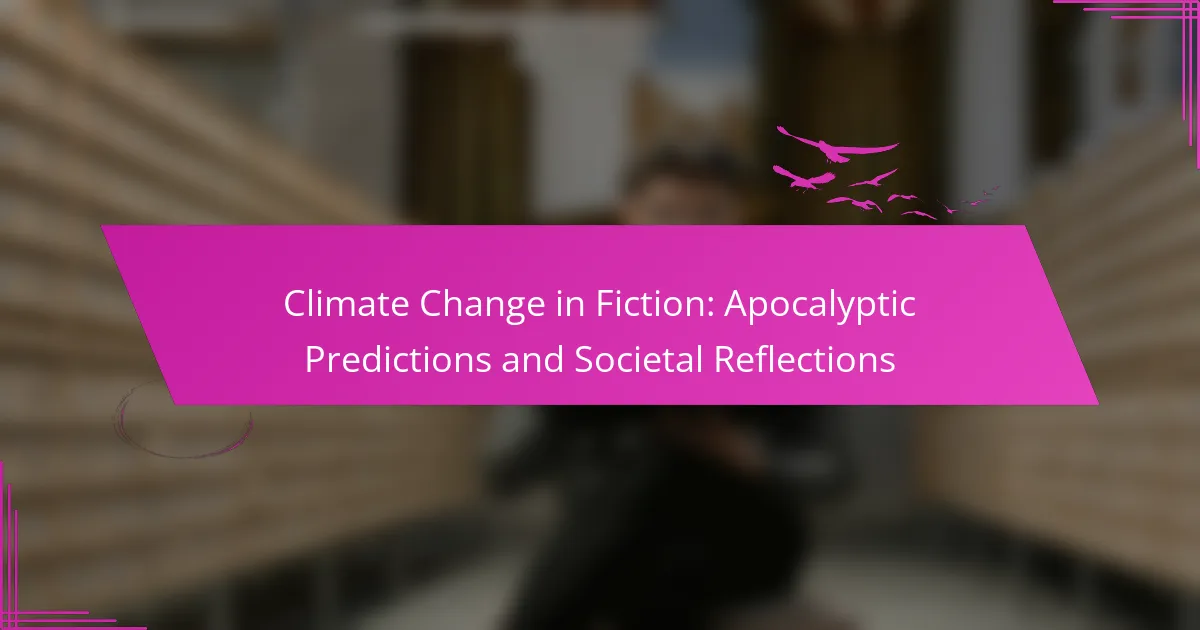Climate change fiction explores societal fears and environmental realities through apocalyptic narratives. It highlights catastrophic scenarios, such as resource scarcity and extreme weather events. These stories reflect cultural interpretations and psychological impacts, emphasizing human resilience and moral dilemmas. Notable works provoke critical discussions about sustainability and inspire real-world action against climate threats.
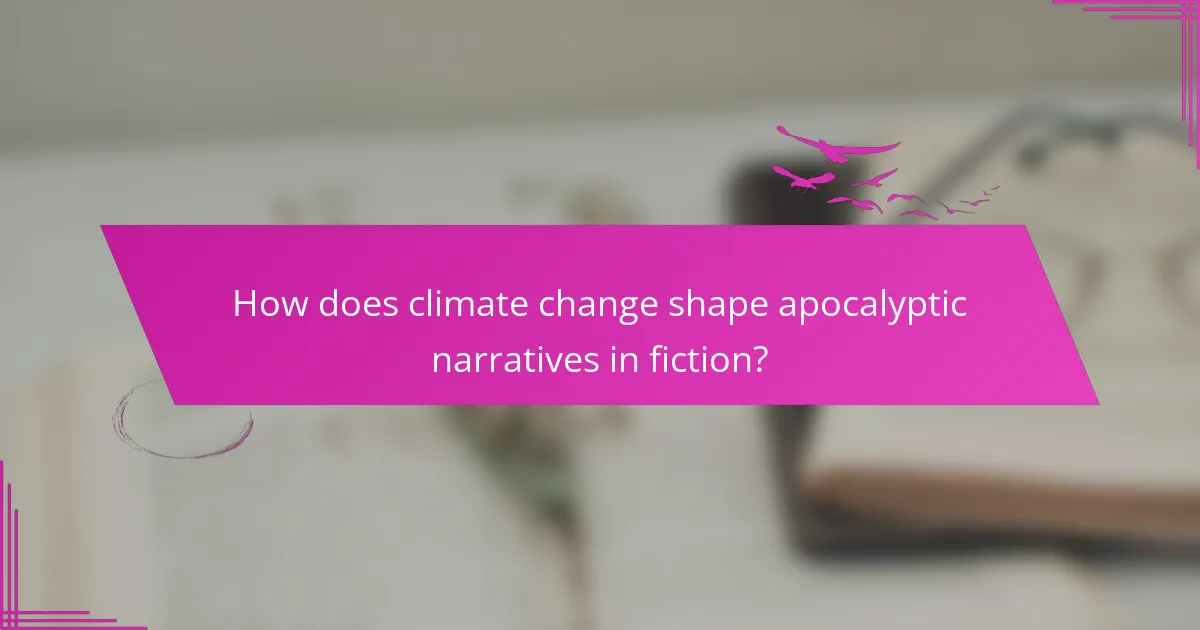
How does climate change shape apocalyptic narratives in fiction?
Climate change significantly shapes apocalyptic narratives in fiction by reflecting societal fears and environmental realities. Authors often depict catastrophic scenarios that arise from climate-related disasters, such as extreme weather events and resource scarcity. These narratives serve as cautionary tales, emphasizing the urgency of addressing climate issues.
For instance, novels like “The Road” by Cormac McCarthy illustrate a post-apocalyptic world ravaged by environmental collapse. Such stories resonate with readers, highlighting the potential consequences of inaction on climate change. As a result, these fictional accounts not only entertain but also provoke critical discussions about sustainability and human resilience.
Additionally, the portrayal of dystopian societies in climate fiction often mirrors real-world political and social dynamics. This connection emphasizes the interplay between environmental degradation and societal breakdown, reinforcing the idea that climate change is a multifaceted threat.
In summary, climate change in fiction acts as a powerful narrative device, shaping apocalyptic themes that reflect both current anxieties and possible futures.
What are the common themes in climate change-related apocalyptic fiction?
Common themes in climate change-related apocalyptic fiction include societal collapse, environmental degradation, and human resilience. These narratives often explore the consequences of inaction, depicting dystopian futures where ecosystems fail and resources dwindle. Characters typically face moral dilemmas, highlighting the impact of climate change on human relationships and survival. Additionally, themes of hope and redemption frequently emerge, showcasing the potential for innovation and cooperation in the face of disaster.
Which authors have notably addressed climate change in their works?
Notable authors addressing climate change include Margaret Atwood, Kim Stanley Robinson, and Octavia Butler. Their works explore apocalyptic themes and societal impacts of environmental crises.
Margaret Atwood’s “Oryx and Crake” presents a dystopian future shaped by genetic engineering and ecological collapse. Kim Stanley Robinson’s “New York 2140” depicts a world submerged due to rising sea levels, emphasizing urban adaptation. Octavia Butler’s “Parable of the Sower” reflects on societal breakdown amid climate chaos, showcasing resilience and community.
These authors use fiction to provoke thought about climate issues, encouraging readers to consider potential futures shaped by current environmental actions.
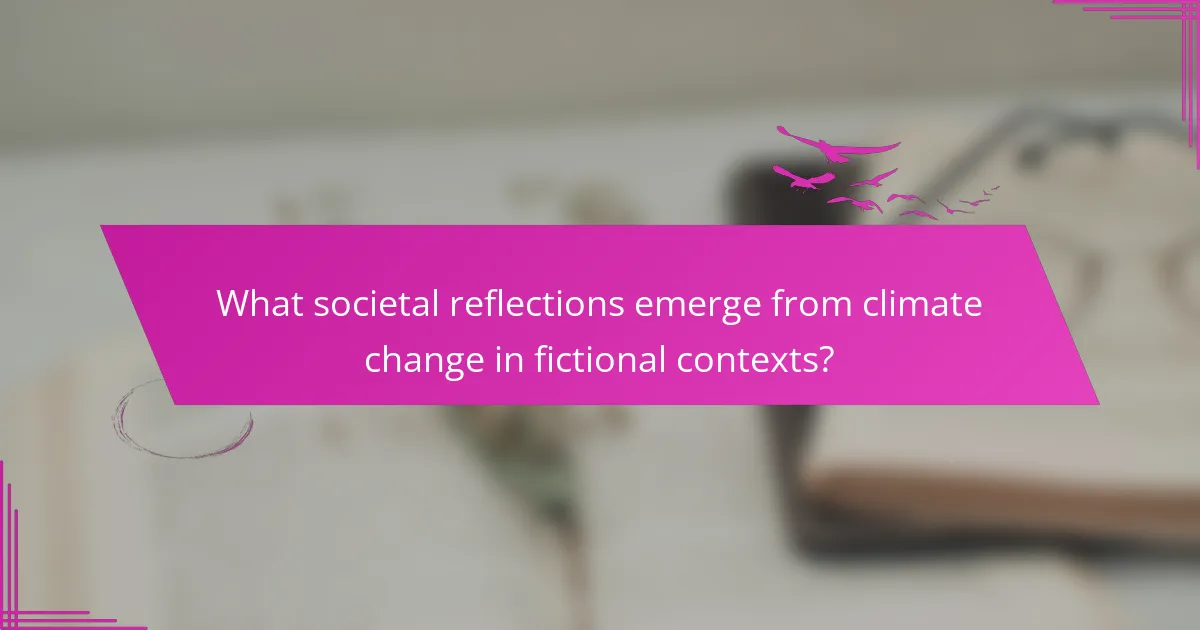
What societal reflections emerge from climate change in fictional contexts?
Fictional contexts reflecting climate change often depict societal collapse, highlighting human resilience and moral dilemmas. Characters grapple with survival, resource scarcity, and ethical choices, revealing deep societal fears. These narratives serve as cautionary tales, urging awareness of environmental consequences. They illustrate humanity’s interconnectedness and the urgent need for collective action against climate threats.
How do characters in these narratives respond to climate crises?
Characters in these narratives often respond to climate crises with resilience, adaptation, and sometimes despair. They reflect societal fears and hopes regarding environmental challenges. Many portrayals highlight the struggle for survival amid apocalyptic scenarios, emphasizing the impact of climate change on human relationships and societal structures. For instance, in dystopian settings, characters may unite to combat environmental decay or face moral dilemmas influenced by resource scarcity. These responses serve as mirrors to real-world concerns, prompting readers to contemplate their own actions regarding climate change.
What role does community play in fictional representations of climate change?
Community plays a crucial role in fictional representations of climate change by illustrating collective responses to environmental crises. These narratives often depict how society adapts, collaborates, or struggles in the face of apocalyptic scenarios.
In many stories, community dynamics highlight resilience and innovation, showcasing how individuals unite for survival and sustainability. For instance, characters may form alliances to address resource scarcity, emphasizing shared responsibility and communal action.
Moreover, these representations reflect societal fears and hopes regarding climate change. They can serve as cautionary tales, urging readers to recognize the importance of community engagement in real-world environmental issues.
Ultimately, fiction can inspire real-life community initiatives by demonstrating the power of collective action in combating climate change.
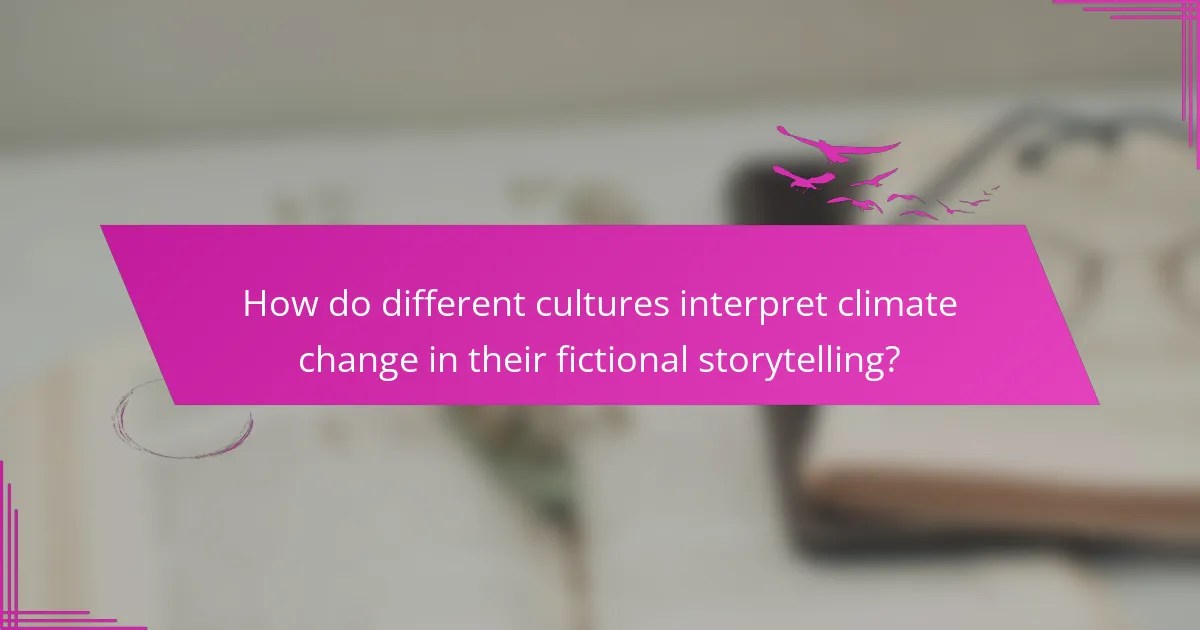
How do different cultures interpret climate change in their fictional storytelling?
Different cultures interpret climate change in their fictional storytelling by reflecting their unique societal values and fears. For instance, Indigenous narratives often emphasize harmony with nature, portraying climate change as a disruption of balance. In contrast, Western dystopian tales frequently depict apocalyptic scenarios, focusing on human conflict and survival. These variations highlight how cultural contexts shape perceptions of environmental crises. As a result, fiction serves as a mirror, revealing deeper societal anxieties and aspirations regarding climate change.
Which regional differences can be observed in climate change narratives?
Regional differences in climate change narratives often reflect local experiences and cultural contexts. For instance, coastal regions emphasize rising sea levels, while arid areas focus on drought and water scarcity. In developed nations, narratives may highlight technological solutions, whereas developing nations often stress vulnerability and adaptation. These variations shape how communities perceive and respond to climate change, influencing both fiction and societal discourse.
How do cultural values influence the portrayal of climate change?
Cultural values significantly shape the portrayal of climate change in fiction. They influence narratives, character motivations, and societal responses to environmental crises. For instance, cultures that prioritize community and sustainability often depict collaborative efforts to combat climate change. In contrast, individualistic societies may focus on personal survival and technological solutions.
These portrayals reflect underlying beliefs about humanity’s relationship with nature. In cultures with strong spiritual ties to the environment, climate change narratives may emphasize reverence for natural elements. Alternatively, cultures with a more utilitarian view may highlight economic impacts and technological advancements.
Moreover, the apocalyptic themes present in many fictional works often mirror societal anxieties related to climate change. These stories serve as cautionary tales, reflecting fears about the future and the consequences of inaction. As a result, cultural values not only influence the content but also the emotional resonance of climate change narratives, shaping public perception and response.
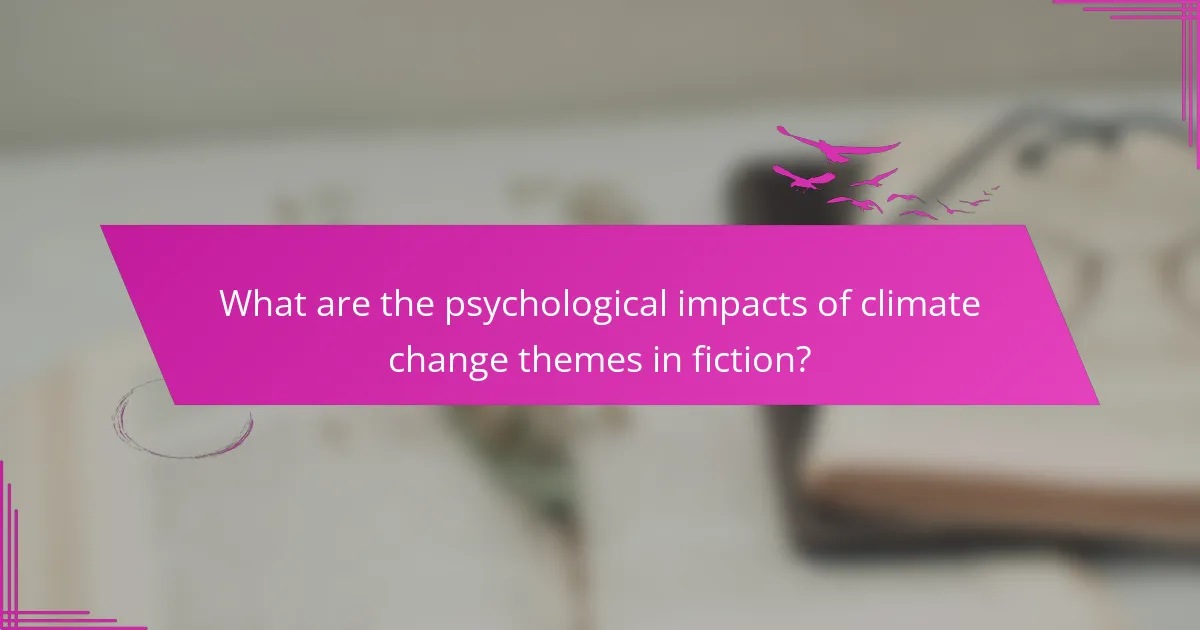
What are the psychological impacts of climate change themes in fiction?
Climate change themes in fiction often evoke anxiety, despair, and a sense of urgency. These narratives reflect societal fears about environmental degradation and its potential consequences. Characters often experience psychological distress, illustrating feelings of helplessness and loss.
Such fiction can foster awareness and provoke discussions about climate action, impacting readers’ emotional responses and motivating change. The portrayal of dystopian futures serves as a warning, influencing collective consciousness regarding environmental issues.
Additionally, these stories can create a sense of community among readers, as they grapple with shared concerns about the planet’s future. The psychological impacts are profound, shaping perceptions and behaviors related to climate change.
How do readers emotionally connect with climate change narratives?
Readers emotionally connect with climate change narratives through relatable characters and urgent themes. These stories often reflect societal fears and aspirations, making the abstract concept of climate change tangible. For instance, apocalyptic scenarios create a sense of immediacy, prompting readers to reflect on their own lives and the future. The unique attribute of personal stakes in these narratives fosters empathy, driving home the reality of climate impacts. As a result, readers are more likely to engage with environmental issues, feeling a sense of responsibility and urgency to act.
What are the implications of apocalyptic fiction on public perception of climate issues?
Apocalyptic fiction significantly shapes public perception of climate issues by dramatizing potential futures. These narratives often emphasize catastrophic consequences, fostering urgency and concern among audiences. As a result, they can inspire action and influence policy discussions. Unique attributes of this genre include its ability to evoke emotional responses and create relatable scenarios, making abstract climate concepts more tangible. Furthermore, studies indicate that exposure to such fiction can lead to increased awareness and engagement with environmental topics.
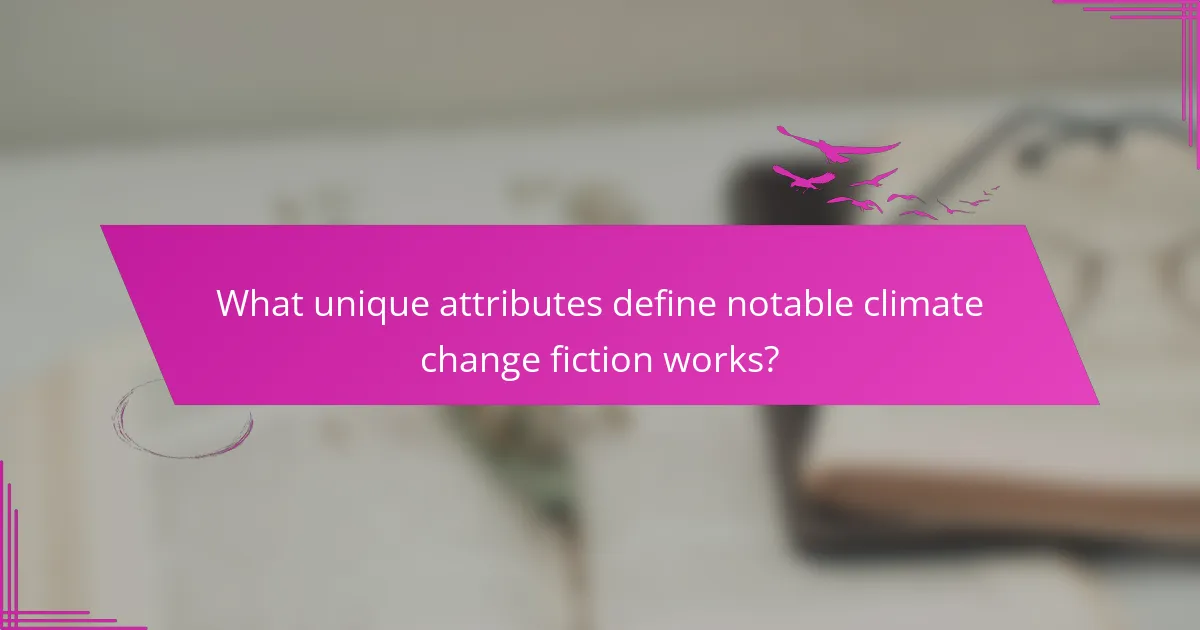
What unique attributes define notable climate change fiction works?
Notable climate change fiction works are defined by their unique attributes such as strong environmental themes, character-driven narratives, and speculative technologies. These works often explore societal collapse, resilience, and moral dilemmas, reflecting contemporary anxieties about climate change. Noteworthy examples include “The Overstory” by Richard Powers, which intertwines human and ecological stories, and “New York 2140” by Kim Stanley Robinson, which presents a submerged city and innovative survival strategies. Such narratives provoke thought about humanity’s future in the face of environmental challenges.
Which specific narratives have gained critical acclaim for their portrayal of climate change?
Several narratives have gained critical acclaim for their portrayal of climate change, emphasizing its urgency and societal impact. Notable examples include “The Overstory” by Richard Powers, which interweaves human stories with environmental themes, and “New York 2140” by Kim Stanley Robinson, depicting a submerged city due to rising sea levels. “The Water Knife” by Paolo Bacigalupi explores water scarcity in a dystopian future, while “Flight Behavior” by Barbara Kingsolver examines climate change through the lens of rural life and ecological disruption. These works reflect diverse perspectives on the consequences of climate change, fostering awareness and dialogue.
What innovative storytelling techniques are used to convey climate change themes?
Innovative storytelling techniques in climate change fiction include immersive world-building, nonlinear narratives, and character-driven plots. These methods enhance emotional engagement and provoke critical reflection on societal issues. For example, authors may use fragmented timelines to illustrate the chaotic nature of climate impacts, emphasizing urgency. Additionally, speculative elements allow exploration of potential futures, fostering discussions about responsibility and action. Such techniques not only entertain but also encourage readers to reconsider their relationship with the environment.
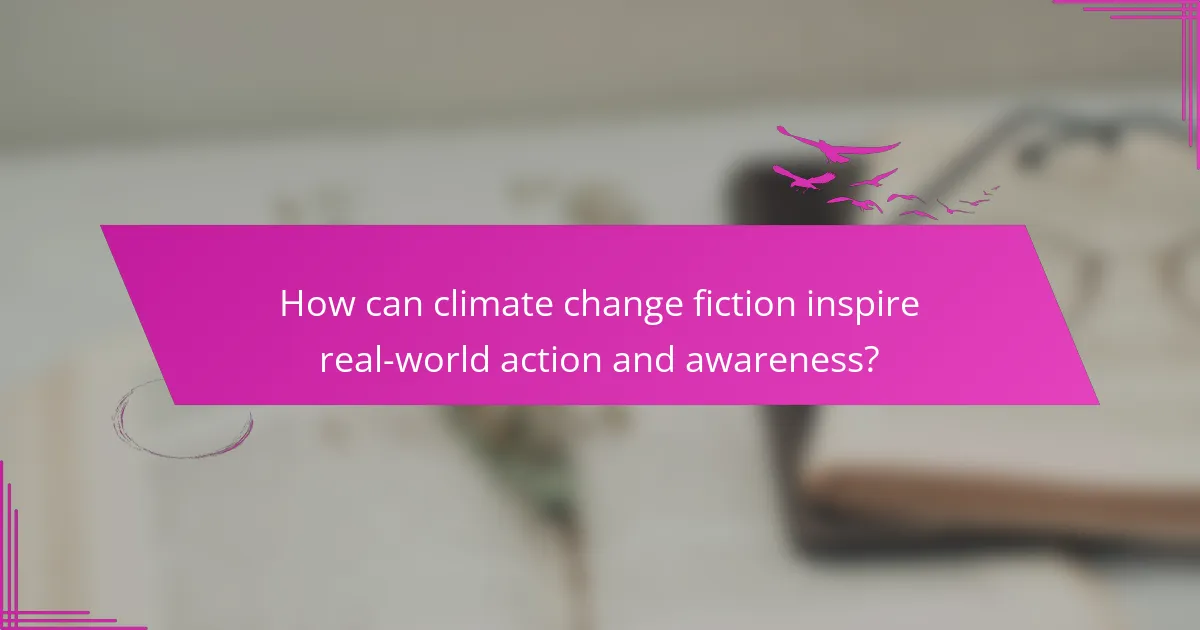
How can climate change fiction inspire real-world action and awareness?
Climate change fiction can inspire real-world action and awareness by highlighting urgent environmental issues. These narratives often depict dystopian futures, prompting readers to reflect on current behaviors and policies. For instance, stories like “The Overstory” by Richard Powers illustrate the interconnectedness of life and nature, motivating individuals to advocate for ecological preservation. Furthermore, climate fiction fosters empathy by humanizing the impacts of climate change, encouraging proactive community engagement. As a result, these fictional accounts serve as powerful catalysts for change, urging society to take meaningful action against climate threats.
What lessons can be learned from fictional representations of climate crises?
Fictional representations of climate crises teach valuable lessons about societal resilience and the consequences of inaction. They often highlight the urgency of addressing climate change, emphasizing the need for collective action. These narratives can inspire real-world discussions on sustainability and environmental responsibility. Additionally, they reflect human adaptability in the face of adversity, showcasing innovative solutions and community strength. Ultimately, these stories serve as cautionary tales, urging audiences to consider the long-term impacts of their choices on the planet.
What strategies can authors employ to effectively raise awareness through fiction?
Authors can raise awareness about climate change through fiction by integrating realistic scenarios and relatable characters. They can utilize apocalyptic predictions to illustrate potential futures, emphasizing consequences of inaction. Crafting narratives that reflect societal responses to climate issues can foster empathy and motivate change. Engaging storytelling combined with factual elements enhances the impact, making complex topics accessible.
What common mistakes should be avoided when writing about climate change in fiction?
Avoiding common mistakes in writing about climate change in fiction is crucial for authenticity and impact. Focus on accurate scientific representation, avoiding clichés and stereotypes. Ensure characters reflect diverse perspectives and experiences related to climate issues.
Incorporate realistic consequences of climate change rather than exaggerating apocalyptic scenarios. Ground narratives in current events and scientific data to enhance credibility. Avoid neglecting the emotional and psychological aspects of climate change, as these resonate with readers.
Finally, steer clear of presenting solutions as overly simplistic; instead, depict the complexity of climate action and its societal implications.
